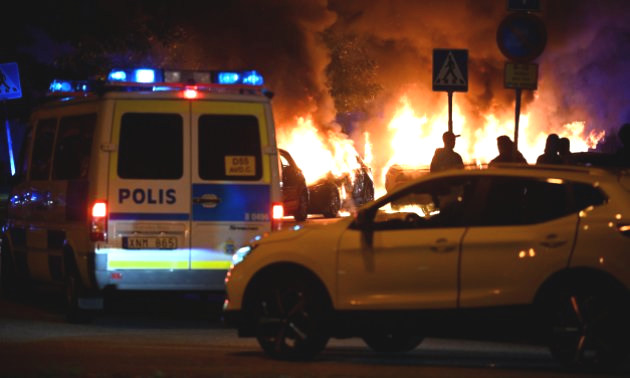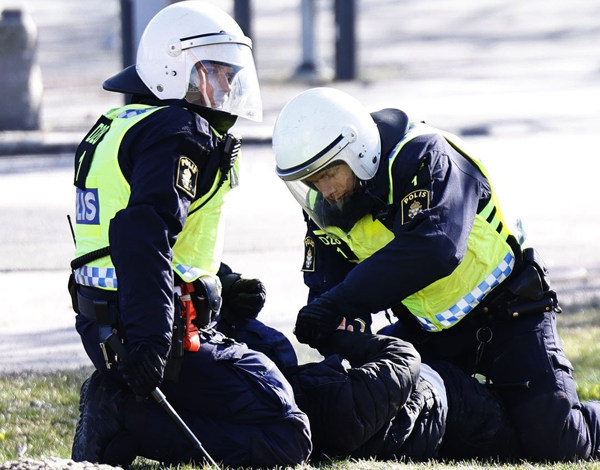Canadians Have Seen This Movie Before:
Thanks to Rapid Immigration Violent Gang Warfare Has Transformed Sweden
Fredrick Karrholm, ‘Sweden’s ‘child soldiers’’, The Spectator, April 6, 2024, p. 14-15
There were 149 bomb attacks in Sweden last year. Though warring gangs are for the most part responsible, ordinary people are increasingly caught in the crossfire. The violence is brutal and ruthless, something I’ve witnessed up close as a police officer in Stockholm and have also analysed as a criminologist. Last year, 28 innocent citizens died or were seriously injured in bombings and shootings. Our country has gone from the bottom of Europe’s gun-crime league tables to the top and it prompts an obvious question: why has this happened in Sweden and why now?

One of the most dismal elements of the epidemic of violence is how often it involves children. Gunnar Strommer, the justice minister, has explained: ‘Criminal networks recruit ten-, 11-year-olds. Weapons and explosives are handled by 12- and 13-year-olds and shootings are carried out in several cases by 14- to 15-year-olds.’ These are known by some as ‘child soldiers’.
‘You have respect on the street if you are a murderer. Many people want to do business with you’
Apart from the relative ease with which gangs recruit and radicalise the young, there’s another reason children are often involved. Anyone under 15 is immune from prosecution in Sweden and cannot be detained by police, even if caught with a gun. According to the police authority’s analysis, a desire for personal status and prestige is what has driven the escalation in gun violence; that, and revenge. In recent years we have seen more advanced gang networks drive the violence – but the underlying conditions for these conflicts is the involvement of the young. ‘Sweden has never seen anything like it before,’ the Prime Minister, Ulf Kristersson, has said. ‘No other country in Europe is seeing anything like it.’
For decades – even centuries – Sweden was known for its culture of non-aggression and conflict avoidance. It’s the last place you’d expect to incubate a new form of ultra-violent gang crime. Aside from isolated instances and occasional shocks, the biggest spate of such violence was when criminal motorcycle gangs were established in the 1990s. The feud between Hells Angels and Bandidos in the mid-1990s ended up claiming 12 lives. Compare this to Sweden last year: 363 shootings, resulting in 53 deaths.
Last week, for example, two leaders of the criminal network ‘Death Patrol’ were charged with murder after a bloody conflict that lasted for many years. This was a rivalry with ‘Shottaz’, another gang from Jarva in Stockholm, where I worked as a police officer. ‘You have retaliation after retaliation: in the end, you hardly know what it started about,’ says my former colleague Kristian Malzoff, now a superintendent. He has also spoken about the problems that ensue when children are given a gun and a mission without much training. ‘An automatic weapon is quite heavy and can be difficult to handle,’ he says. ‘It is easy for a child to shoot “too much”. Maybe you go too close or you get scared, or you stand further away and hit the wrong thing.’
 Often the violence seems bewilderingly random. The house next door to that of a gang member is blown up. Why? The answer is sometimes that a child assailant simply got the wrong address.
Often the violence seems bewilderingly random. The house next door to that of a gang member is blown up. Why? The answer is sometimes that a child assailant simply got the wrong address.
It’s a sign of the macho, prestige-orientated culture that gang leaders have names like the Greek and the Kurdish Fox. A few months ago, courts heard the case of a 15-year-old who killed in return for 85,000 Krona (around £6,300) in cash. ‘I shot I kill,’ he wrote to a friend. ‘Hahahahahaha. Head shot?’ came the reply. The shooters are children, laughing and bragging to other children. The adult sentence for this crime would have been life imprisonment; the most severe punishment for a murderer aged 15 is four years in youth detention. This is one of many shortcomings that the new government is in the process of addressing.
The Swedish Police Authority states that the number of active individuals in criminal networks is estimated to be around 14,000, and approximately 48,000 people have ties to organised crime. In Uppsala, a local police survey has identified that a quarter of all gang criminals are under 18. According to Jale Poljarevius, head of police intelligence in the city, the youngest on their books is just ten. Not all of these children are trigger-happy. Some are forced to commit crimes, under threat of having their parents shot (and this certainly happens), but more often the violence is a rite of passage. Poljarevius mentions a saying: ‘Jag kan brösta en fyra, för att bli en hundragubbe.’ The crude translation is: ‘I can handle four [years] to become a 100-guy.’ In other words, you’re not deterred by four years in youth care for a murder. And you’ll be regarded as a full-fledged gang member when you get out.
Both the victims and the perpetrators of Swedish shootings are almost always boys and young men with a foreign background. They’ve been raised or are living in marginalised areas with a clear gangster culture. The values that define this culture have even inspired a new genre of music. On Spotify in Sweden there are several popular rappers who describe – and reproduce – the gangster ethic. To an alarming extent, the life is seen as glamorous. ‘It has become trendy to murder,’ a former gangster told a reporter from SVT, the national public broadcaster. ‘You have respect on the street if you are a murderer. There are many people who want to come and do business with you.’
Immigrants and their descendants comprise about a third of Sweden’s current population and this change has happened in a very short space of time. But all too often, certain groups have become a society within a society. ‘We now have parallel societies in Sweden,’ said Magdelena Andersson before she lost power as prime minister in October 2022. ‘We live in the same country, but in completely different realities.’
It’s not surprising that subcultures have emerged in immigrant-dense marginalised areas. Such segregation – both physical and economic – has been an inevitable consequence of previous migration policies, which until recently were immensely generous. This particular subculture has its own patois with which I became familiar through thousands of interrogations and conversations. It’s a blend of foreign influences, primarily from the Middle East – and, though relatively new, has grown so strong that it has begun to influence middle-class youth culture. Even blond middle-class boys are drawn to the Scandi-gangster aesthetic which is characterised by a mentality of revenge and the romanticisation of violence. It not only harbours contempt for the police but also questions the legitimacy of the entire state. The police engaged in targeted efforts against Swedish gangs say the culture is fast becoming nastier and more sophisticated and is now boundless in its use of violence. But they haven’t lost hope.
Sweden has, after all, transformed its society before. Over hundreds of years the country moved from a warlike culture to one marked by self-control, law-abidingness, tolerance, rationality, consensus and kindness. You only have to read the Icelandic sagas, which narrate the history of the Nordic region, to see how deadly violence was once a natural means to avenge insults and resolve conflicts. One saga tells of a young man, Gunnar, who learns indirectly that he has been mocked and deems this reason enough to kill. The perceived slight consists of a trivial assertion that he cried during an accident and the story culminates in a brutal act of revenge murder. It could be a news story from the papers today.
Sweden left behind that violent past and built a strong and peaceful society which was renowned across the globe, and with it a criminal justice system founded on principles of liberal democracy that Swedes still hold dear. Outsiders may wonder why sentences for child gangsters are still so lax. The answer is, perhaps, a deep reluctance to let go of our peaceful and forgiving traditions, and to have the rules of an entire country changed by a minority of criminals. However, for most, the realisation has dawned that taking tough measures is necessary.
The minority culture of violence that has emerged in the past ten years can certainly be quelled. Jailing obviously dangerous criminals is necessary, but it is not sufficient – we now need to champion a renaissance of our old, peaceful values.
Fredrik Karrholm is a member of the Swedish parliament and the author of Gangster Violence.





You must be logged in to post a comment.